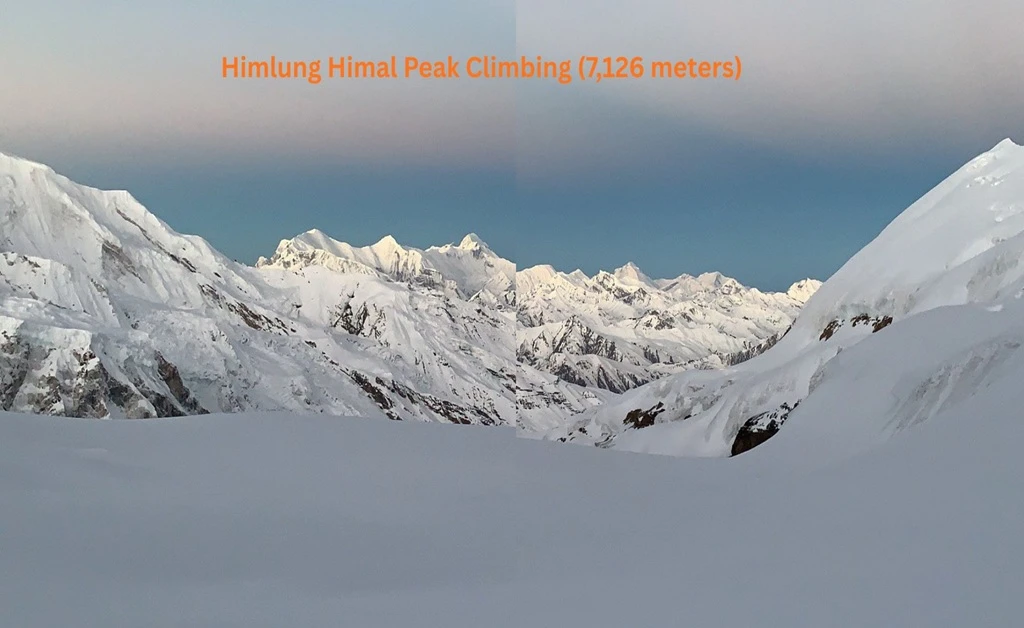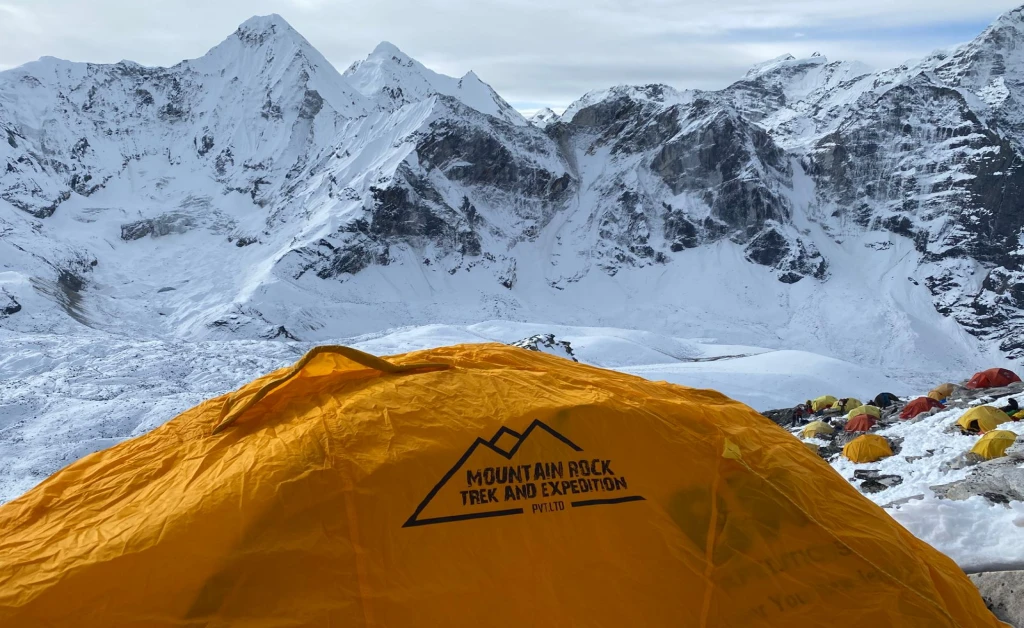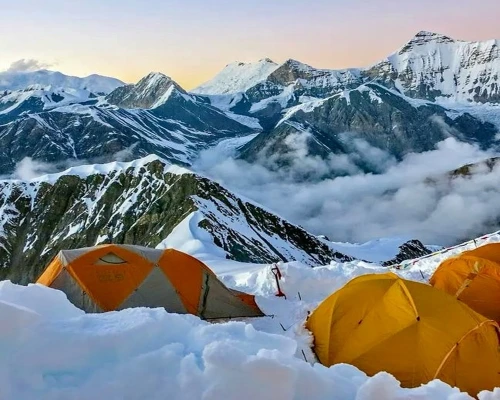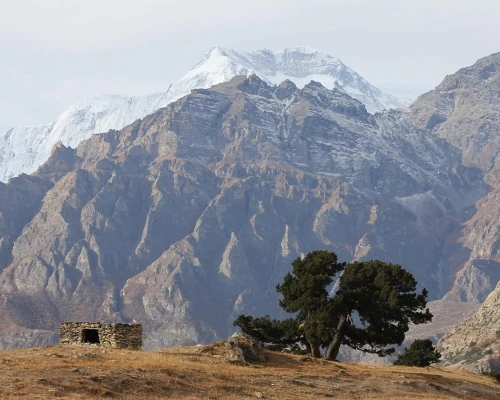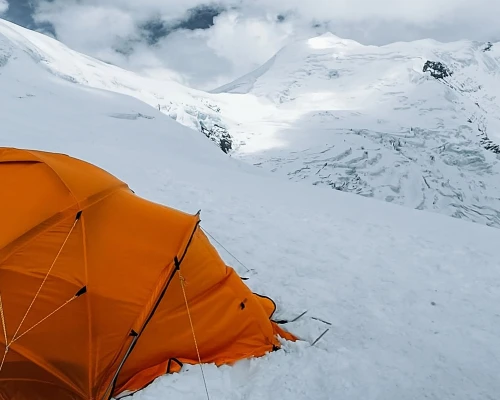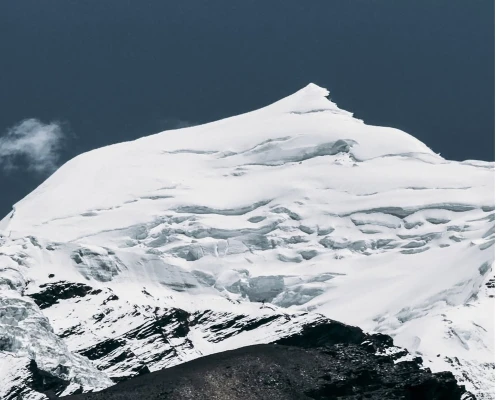Himlung Himal Expedition
The 2026 Himlung Himal Expedition is an exciting 29-day trip for climbers to attempt to summit one of Nepal's truly spectacular 7000-metre peaks.
Himlung Himal is located in the Manaslu area of Nepal, in a remote region, and is an impressive 7,126 meters (23,405 feet). Himlung Himal provides climbers with a stunning view of the Himalayan mountain range, some technical climbing, and a high altitude experience that every climber should have.
The adventure will start with a tentatively planned day in Kathmandu to get the permits and arrange logistics for the mountain. From there, we will travel to Khudi. This is also where the trek to base camp will begin, to 4,900 meters, and there will be some incredible Nepali towns and beautiful terrain to see along the way.
This expedition is designed mainly for climbers who have experienced climbing at high altitude. This is a full-service expedition for 29 days, which will support you in your preparation and climbing on the expedition and to the summit. Our main goal is for successful ascent to the summit, with safety being the highest priority
The main climbing route mainly follows the North Ridge with sections of glaciers, moraines, steep snow slopes, icy walls, and navigating crevasses. It is not the highest regarded of the 7000-meter peaks in terms of technical difficulty, but Himlung requires solid mountaineering skills and previous high-altitude experience to deal with its difficult sections of ice and rock climbing, snow slopes, and unknown conditions.
Climbers will acclimatize for several days and go on rotations between camps I, II, and III at an altitude of 5,400 meters to 6,300 meters, before the summit push.
In 1983, a Nepalese-Japanese expedition was the first to successfully summit Himlung Himal, and it has since become a popular option for adventurers looking for a remote location to undertake a similarly rewarding climb in the Himalayas.
Climbers looking for experience leading to and including an 8000-meter climb, Himlung is a great fit. Climbers receive the support of experienced guides, Sherpas, and staff for the 29-day program, ensuring safety, logistical support, and good camping quality.
Besides a summit attempt, this expedition will also provide an opportunity for cultural interaction with villages nearby, in the Ganesh Himal region, which is much more than a mountaineering experience.
This is an all-inclusive package with permits, guiding, equipment, and meals, which are all suitable for physically and mentally challenged visitors in an easy-going Himalayan atmosphere on this most memorable trip.
Himlung Himal Expedition 2026 will provide ample opportunity for adventure, culture, and nature in the Himalayan higher peaks of Nepal.
At Mountain Rock Treks, we organize the Himlung Himal Expedition at the optimum times of the year - autumn and spring - and we give the best package price starting at $5000 per person for groups. We are taking bookings now for this exciting experience of peak climbing. Once you have booked, you are welcome to visit our office and meet the team, who will then give you a detailed briefing of the entire climbing process and a roadmap of the expedition. Contact us now for lots more details and to secure your booking for an exciting expedition in the Himalayas.
Himlung Peak Climbing Highlights
- Climbing one of the easiest and most technically accessible 7,000-meter peaks in Nepal, with a height of 7,126 meters (23,379 feet).
- Familiarize yourself with prevailing camps at the altitude of Camp I (5450m), Camp II (6000m), and Camp III (6350m) in order to be able to acclimatize, and be ready to go to the top.
- Trek through the more wild and less visited areas of Annapurna and the Manaslu conservation areas for a balanced experience with nature and cultural aspects.
- Experience the typical Tibetan mountain settlements and communities with a strong affinity to traditions of Buddhism, which allows for an enthralling and rewarding cultural experience.
- Be amazed with stunning mountain views of Annapurna, Manaslu, Ganesh Himal, Pisang Peak, Gyaji Kang, and beyond.
- Enjoy diverse nature: snowfields, glacial moraines, rocky ridges, rhododendron forests, oak, and pine.
- There are also chances to see Himalayan wildlife such as Himalayan tahr, musk deer, blue sheep, and birds of various species.
- The climbing features some minor technical difficulties suitable for climbers with more than 6,000 meters of experience, thus making it an excellent high-altitude mountaineering introduction.
- The summit provides a fantastic 360-degree view of the Himalayas and the Tibetan plateau, thus creating a memorable mountaineering experience.
- Extensive flora and fauna in the Manaslu and Annapurna Conservation Areas, including animals such as blue sheep, musk deer, and numerous bird species.
- The summit provides a complete panoramic view of the neighboring Himalayan ranges and the Tibetan Plateau.
- On their way, the climbers cross different terrains with glaciers, rivers, ancient monasteries, peaceful campsites, and some stunning natural features like waterfalls and lakes waiting to be explored.
- The whole journey lasts approximately 27-29 days and offers a perfect blend of trekking and climbing for a complete Himalayan adventure.
- Combines trekking in the Annapurna region with visiting the remote and culturally rich Nar and Phu Valleys.
7000 Meters Himlung Himal Peak Climbing Profile
Item | Details |
Peak Name | Himlung Himal |
Elevation | 7,126 m (23,379 ft) |
Location | Nar-Phu Valley, Manang District, Gandaki Province, Nepal |
Mountain Range | Peri-Damodar or Peri Himal range, northeast of Annapurna range |
First Ascent | 3 October 1992 by a Japanese team (Osamu Hanai, Akio Koizumi, Nima Sherpa) |
Access / Trek to Base Camp | Typical route: drive from Kathmandu to Besisahar/Koto → trek via Meta/Kyang/Phu to Base Camp at ~4,900 m. |
Base Camp Elevation | around 4,900 m (some sources say 4,800–4,900 m) |
High Camps | Camp 1 at near to 5,400–5,614 m; Camp 2 near to 6,000 m; Camp 3 around 6,300–6,400 m |
Standard Route | Usually via the South-West or North-West Ridge (glacier travel + snow slopes) |
Difficulty / Technical Grade | Rated moderate (Alpine grade PD + to AD) |
Best Seasons | Spring (April–May) & Autumn (September–November) |
Typical Expedition Duration | Around 25-30+ days door-to-door (incl. trek out & acclim) |
Permit / Region | The region is restricted (Nar-Phu valley) – special permit required. |
Why It’s Good for Clients | Less technical than many 8 000 m peaks, excellent training for higher climbs, very scenic & remote. |
Challenges / Considerations | High altitude (above 6 500 m) for many days, glacier travel, weather uncertainty, remote location. |
Views from Summit | Panoramas of Annapurna range, Manaslu, Dhaulagiri and other peaks. |
Where is Himlung Himal Located?
Geographical and Administrative Location
Himlung Himal is situated at 7,126 meters in the northern part of central Nepal in Nar Phu Valley (or Naar-Phu), located in Manang District, which is in Gandaki Province.
Context within Mountain Range
The peak is located between two major sub-ranges of the Himalayas: the north-east of Annapurna, and the north-west of Manaslu. The mountain is also located very near the border with Tibet (China) to the north.
Coordinates and Terrain
Himlung Himal is around 28° 46′ 18″ North latitude and 84° 25′ 29″ East longitude. The terrain is steep and remote, with trekking done to reach the base camp at an altitude just below 4,800 - 4,900 meters, where you will haul gear up to higher camps.
Getting There and Trip Details
Generally, the approach (unless specified otherwise) from Kathmandu would be to drive or jeep to Besisahar, jeep to Koto, located in the Marsyangdi valley, east/north through small villages (Meta, Kyang, and Phu Gaon), and ultimately reach the Base Camp of Himlung Himal by trekking to the Base Camp via the Nar-Phu Valley route.
Himlung Himal Expedition in Autumn 2026
The Autumn season, and especially the months of October/November, are some of the most favorable months for the ascent of Himlung Himal, 7126 m. Our Fall Expedition in 2026 will provide clear skies, stable weather conditions, and spectacular views at altitude.
Our expedition will begin in Kathmandu and proceed on foot through the remote Nar-Phu Valley of the Manang District, Nepal, before attempting the summit of Himlung Himal. This adventure is a combination of cultural trek, wildness trek, and serious climbing and mountaineering; this is ideal for a client who requires more than just a trek.
Why Autumn in 2026 for Himlung Himal Climbing?
There are definite advantages to starting on your expedition in Autumn. Following the monsoon season, conditions tend to have less precipitation, and visibility of the surrounding mountains, including the Annapurna range and the Manaslu region, is often better, and windows of a more stable climbing opportunity tend to occur.
Not only do we get perfect climbing conditions, but choosing to set up Autumn 2026 gives a good time base in advance of the trip for logistics, client preparation, and securing permits (as they generally get more expensive the closer you are to the departure date).
For your travel company, it is also exciting to market a "the season" expedition to your clients, as this would be great for clients who take climbing seriously.
Cost for Himlung Himal Expedition (Autumn 2026)
For Autumn 2026, we are offering a cost structure that is based on the size of the group:
- 2 persons $6,500 per person
- 3-6 persons $6,000 per person
- 7-10 persons $5,500 per person
- 11+ persons $5,000 per person
As noted above, the pricing reflects discounts for group size, and also helps with the fixed‐cost logistics and fixed costs, and subsequently the per-person trip costs.
Permits and Government Fees
- Climbing permit (royalty) fee for Himlung Himal: the royalty fee in the Autumn season is considerably less than in the peak spring season.
- Restricted Area Permit (RAP) for the Nar-Phu Valley approach, Autumn (Sep-Nov) rate of approx USD 100 per person per week.
- Conservation / National Park related permits (e.g., entry into Annapurna Conservation Area (ACAP), approx USD 25 per person.
- Other costs: liaison officer costs, garbage deposit, possible summit bonus for Sherpa support, etc. These costs may be included in your package cost, but we will be sure to account for them.
We will also include the permit costs and admin fees in your package, so there are no hidden surprises as far as fees go. For clients, this clarity and transparency are a huge benefit and will earn trust in our travel company, Mountain Rock Treks.
Safety and Support In Autumn
We will provide a full Basecamp service. Transfers in Nepal are included, as well as government-certified climbing and trekking guides with experience, along with an extra-high altitude Sherpa resource. The same climber-to-Sherpa ratio works as 1:1 or 1:2 with the group/season size.
We provide tents and expedition gear at Base Camp and camps above. Along with this, Basecamp service is our rope fixing, emergency oxygen, communication, and medical insurance for Nepali staff. Clients receive the full service. This provides reassurance that professionals manage the expedition and that their safety on the mountain will be taken care of.
Himlung Himal Expedition Booking for Autumn
We highly recommend booking early (with a deposit) for Spring 2026. 7,000 m climbing places are very in demand, and the professional service fills quickly.
We will put together a planning itinerary, gear lists, medical requirements, and a payment plan. For the client, this provides peace of mind as they have their dates confirmed, full time to prepare, and assurance of departure.
Himlung Himal Expedition in Spring 2026
Spring 2026 presents the perfect opportunity to attempt this remote high-altitude 7126m peak. After the long winter, there will be compacted, stable snow, and the Nar-Phu Valley will be more peaceful, allowing climbers to take in the high-altitude, beautiful scenery, relaxing snow-covered mountains, and diverse culture at leisure.
After the initial leg of the trip to Kathmandu, you will trek through the Manang region and the Nar-Phu valley, where permits are needed, until base camp, and start your climb.
Why is Spring the Best Season?
Between April and May, spring climbing has favourable conditions as well as fewer climbers as compared to the autumn climbing seasons, which tend to be busier. With the spring weather, the snow is still packed, which means there are fewer hazards on the steep slopes and glaciers.
Himlung Himal in Spring Cost
For Himlung Himal, the climbing permit (royalty) price for spring is higher than the autumn permit price. In the spring, for example, the average price is USD 500 per climber. Also, the Nar-Phu Valley approach has a restricted status (a special permit is needed, costing about USD 100 per week). There are also the ACAP (Annapurna Conservation Area) permit costs, plus other fees/permits.
Our Package Costs: Based on a group size (which you can increase per your company’s model):
- 2 persons: USD 6,500 each
- 3-6 persons: USD 6,000 each
- 7-10 persons: USD 5,500 each
- 11+ persons: USD 5,000 each
These costs include logistics support, permits, base camp/tents, and acclimatization days (make sure to indicate if these things are included or not). The larger the group, the lower the fixed costs per person are (permit costs and liaison officer common cost) - which equals value for clients, and logistical efficiency for your company.
Safety and Support for Spring Himal Expedition 2026
For the Spring 2026 expedition, we will be providing full logistical expedition support. This includes government-licensed climbing guides, Sherpa support, high-altitude porters, swimming in at base camp and high camp, rope fixing, communications support (sat phone at base camp), standby emergency oxygen, and a full acclimatisation schedule.
For our clients, this means they can enjoy a professionally managed climb in a remote region, and for your company, it means you can deliver the high-quality adventure you are known for.
Why is Himlung Himal (7,126 m) Ideal for Mountaineers?
Stepping stone to a 7,000-metre peak
At 7,126 m, Himlung Himal is a “7-thousander”, not just a trek peak; it affords clients serious altitude experience, but not the level of risk that comes with climbing to an 8,000 m peak.
So we say: If a client has climbed a 6,000 m peak and wants to take the next step, climbing Himlung is a logical next step.
Some technical difficulty
The base route itself is technically difficult (glacier crossings, snow slopes, crampon and ice axe use), but not overly technical (or demanding) as compared to climbing 8,000 m peaks.
In other words, It hits the sweet spot for climbers with some experience (not complete novices). Very good fit for many adventure tourists.
Elevation Triumph & Safety Reputation
Unlike many of the 7,000-meter climbs, Himlung is one of the most accessible and "safer" climbs considering the logistics, weather windows, and route.
For the client, more confidence in summiting the peak offering better value and less disappointment.
Beautiful, Less Distraction Journey in the Wilderness
Due to the remoteness of the valley (Nar Phu valley, Manang region), the approach and the base camps do not see as much traffic as other climbs, resulting in a lower quantity of climbers and a cloistered environment.
For the climber, this is not just a climb; this is an expedition experience with culture and wilderness.
Laying the Groundwork for 8000m Climbs
For climbers looking forward to 8000-meter peaks in the future, Himlung is a very good training experience with high altitude exposure, multiple camps, steeper slopes, and glacier travel.
Expedition Options: Standard vs Extended Packages
Feature | Standard Package | Extended Package |
Duration | near to 25-30 days, from Kathmandu → summit summit → return | near to 30-35 days (additional acclimatisation days, side-treks, rest days) |
Approach & acclimatisation | Single summit rotation, with limited buffer days | More gradual approach to acclimatisation; a few extra days in Nar-Phu or the side valley for acclimatisation. |
Summit push flexibility | Need experience, as there is less leave/time available | Built in more summit attempts or contingency days |
Client profile | Experienced climbers with limited leave/time | For clients who have time, prefer to maximise success probability, and/or want to enjoy more terrain. |
Cost (inclusive) | Less expensive than longer itineraries | More expensive due to extra days of support and logistics, and longer itinerary duration. |
Benefits for clients | Fast itinerary and summit goal focus | More time to prepare/acclimatisation and therefore relaxed schedule: increased comfort margin, and increased cultural/trekking value. |
Risk mitigation | Less buffer for delays or weather holds | More buffer days will lessen rush and/or tiredness and therefore lower the risk of altitude-related issues. |
Standard Package
This option is appropriate for clients experienced in mountaineering, physically fit, and have moderate flexibility with their time. Clients will have a streamlined itinerary to Base Camp, then through high camps, and a summit push.
The overarching advantage is that with fewer extra days, there is more expedition focus, which is more budget-friendly.
Expanded Package
This option is designed for clients who want to experience comfort and culture while having a better chance of success, instead of the speed of the expedition.
Having more days allows you to plan day hikes, full acclimatisation/rest days, and a slower (more relaxed) pace along the less-travelled scenic and remoter approaches (i.e. further into Nar-Phu valley or other villages at a higher distance).
This is a premium offer. For climbers this package offers more time in the area, less altitude and a better chance of summiting.
Cost and Climbing Permits
In both packages, you will need to factor in basic financial costs: climbing permit (royalty) for Himlung, Restricted Area Permit (Nar-Phu valley), conservation area permits - ACAP, etc., liaison officer, fixed base-camp gear, trekking and climbing support, logistics. As one source said, permit and logistic costs can be as much as USD 500-700 per person in the spring for Himlung, for instance.
Since fixed costs are not incurred in a strictly linear way with extra days, costs for the Extended Package will logically be higher (for extra days, extra logistical support, more high-camp rotations, more supplies). However, larger groups and good planning can still make it cost-effective.
Why is Himlung Himal Climbing Also Called Preparation Expedition?
Himlung Himal (7,126 m) is often viewed as a training expedition for climbers advancing to higher exploration, such as summiting the larger 8,000-meter peaks like Everest, Manaslu, or Cho Oyu. Part of this is due to the combination of the technical and altitude experience, so preparation and skill building are almost a must for climbers, thinking ahead to a higher ascent.
Successful climbing of Himlung Himal provides climbers with the skill sets, abilities, and experience to pursue asthmatically more challenging 8,000-meter peaks. It is a practical training environment to prepare for the high altitude ascent - sitting on the rock or the knife-edge, route sizing, looking at the weather, and even preparing for emergencies.
For many mountaineers, Himlung Himal is another important stepping stone on the way to climbing higher and higher. It allows for the development of skills and confidence with the knowledge that you are working in an altitude progression.
In the end, the Himlung Himal is a well-rounded preparation expedition that enables climbers to refine their skills, build endurance, and gain experience to tackle the world's tallest summits.
Why Choose Mountain Rock Trek For Your Himlung Himal Climbing?
- Professional Leadership: Our group features experienced Sherpas and certified guides who have ample experience climbing in high-altitude areas.
- Full Service: We will provide all the necessary permits, including the Himlung climbing permit, Nar Phu restricted area permit, and Annapurna Conservation Area permit, to ensure you have a simple experience.
- Custom Itineraries: Our itineraries, whether standard or extended, are created to ensure you acclimatize properly to the conditions and gain maximum success in summiting.
- Cultural Experience: Trek through the culturally abundant Nar Phu Valley with Tibetan Buddhist and indigenous customs.
- Commitment to Safety: We prioritize safety with ample insurance coverage, sat phone communication, and emergency oxygen if necessary.
